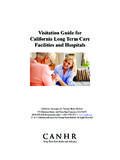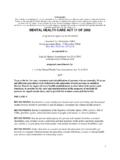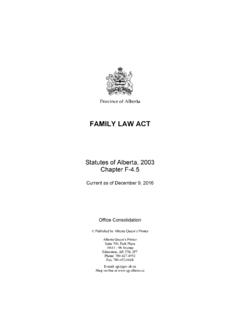Transcription of Assisted Reproductive Technology National …
1 Assisted Reproductive Technology National summary report Belgium 2015 College van Geneesheren Reproductieve Geneeskunde Coll ge de M decins M decine de la reproduction College of Physicians Reproductive Medicine 6 December 2017 Aknowledgement College van Geneesheren "Reproductieve Geneeskunde"/ Coll ge de M decins "M decine de la reproduction " C. Wyns, President D. De Neubourg, Vice-President A. Delvigne, Secretary C. Blockeel, Secretary T. Coetsier, Member F. Devreker, Member S. Gordts, Member S. Perrier d Hauterive, Member Data handling and analysis Interuniversity Institute for Biostatistics and statistical Bioinformatics KU Leuven & Universiteit Hasselt A.
2 Belmans, K. Bogaerts, E. Lesaffre Ecole de Sant Publique Universit de Li ge A. Albert, N. Gillain, M. Guillaume, E. Husson This report is electronically available at 3 Table of Contents Aknowledgement .. 2 Introduction to the National summary report 2015 .. 5 National summary Table .. 6 Section I: Overview .. 6 Where are Belgian ART clinics located, how many ART cycles did they perform in 2015, and how many infants were born from these ART cycles? .. 7 What types of ART cycles were performed in Belgium in 2015? .. 8 How old were women who used ART in Belgium in 2015? .. 9 Section 2: ART cycles using fresh nondonor eggs or embryos.
3 10 What are the steps for an ART cycle using fresh nondonor eggs or embryos? .. 10 Why are some ART cycles canceled? .. 11 How are success rates of ART measured? .. 12 Using ART, what is the risk of having multiple infant live birth?.. 13 Using ART, what are the risks of having a preterm birth infant? .. 14 Using ART, what are the risks of having a low-birth-weight infant? .. 15 Do percentages of ART cycles that result in pregnancies and live births differ among women of different ages? .. 16 How does a woman s age affect her chances of progressing through the various stages of ART? .. 17 What are the causes of infertility among users of ART?
4 18 Do percentages of ART cycles that result in live births differ for women who use ART for the first time compared with women who previously used ART? .. 20 How many embryos are transferred in an ART procedure? .. 21 How do percentages of embryos transferred that result in implantation differ among women of different ages? .. 22 How long after egg retrieval does embryo transfer occur? .. 23 Section 3: ART cycles using frozen nondonor embryos .. 24 How do percentages of embryos transferred that result in implantation for frozen nondonor embryos differ among women of different ages? .. 24 What is the percentage of transfers that results in pregnancies and live births for ART cycles?
5 25 Using ART what is the risk of having multiple infant live births? .. 26 Using frozen nondonor ART cycles, what are the risks of having a preterm birth infant? .. 27 Using frozen nondonor ART cycles, what are the risks of having a low-birth-weight infant? .. 28 Section IV : ART cycles using donor eggs .. 29 4 Do percentages of transfers that result in live births differ by recipient age between women using ART with fresh donor eggs and those using ART with their own eggs? .. 29 What is the risk of having a multiple infant live birth from an ART cycle using fresh donor eggs? .. 30 Section 5 : ART Trends.
6 31 Is the use of ART increasing? .. 31 Is the use of ICSI increasing? .. 32 Has the percentage of transfers that resulted in live births for all ART patients changed? .. 33 Has the number of embryos transferred changed in fresh nondonor cycles? .. 34 References .. 36 Appendix A: Glossary of Terms .. 38 5 Introduction to the National summary report 2015 Data provided to the Belgian registration system of Assisted Reproductive Technology (ART) give an overall National picture of factors that contribute to the quality and success of ART treatment performed in Belgium with the aim to obtain one healthy live-born infant.
7 Some of these factors are patient-related and therefore outside a center s control ( woman s age, cause of infertility, ..). Information about the factors that contribute to a successful ART treatment give potential ART users an idea of the average chances of success. Average chances do, however, not always apply to a particular individual or couple pointing consequently to the need to take complementary medical advice. This report summarizes data of all individual A (16) and B (18) ART centers. The 35639 cycles performed in 2015 at these reporting centers led to 5694 live births.
8 The 2015 National summary table is presented on page 6. The report also includes a number of charts and graphs to answer specific questions on ART treatments or trends. The figures are organized according to the type of ART procedure used. Some ART procedures use a woman s own eggs (nondonor), and others use donated eggs or embryos, although sperm used to create an embryo may also be either from a woman s partner or from a donor. Data are presented according to the source of the egg. Embryos that develop may be transferred back to the woman during the days following the retrieval of eggs (named here fresh embryo transfer) or after cryopreservation for transfer at a later date (named here frozen embryos).
9 Data on frozen embryos include therefore data on embryos that may have been frozen many years before the cycle started in 2015. The National report has 5 sections: Section 1 (Figures 1 through 3) presents general information on the number and location of ART centers, number and types of ART cycles performed; age of women having undergone these treatments and number of infants born from ART cycles. Section 2 (Figures 4 through 16) presents information on the ART cycles that used only fresh nondonor eggs or fresh embryos from nondonor eggs. Section 3 (Figures 17 through 21) presents information on ART cycles that used only frozen embryos from nondonor eggs.
10 Section 4 (Figures 22 and 23) presents information on ART cycles that used only donated eggs. Section 5 (Figures 24 through 28) presents trends in the number of ART procedures performed over the last 10 years and their success rates. Percentages in figures do not always add up to 100 due to rounding. 6 National summary Table . 2015 ART CYCLE PROFILE Type of ARTa IVF 17% With social security 84% ICSI 76% Used PGD 4% Mixed (IVF + ICSI) 8% 2015 ART SUCCESS RATES Type of Cycleb Age of Woman <36 36-39 40-42 43 Total Fresh Embryos from Nondonor Eggs Number of cycles 11321 5057 3786 459 20623 Percentage of cancellations Average number of embryos transferred Percentage of embryos transferred resulting in clinical implantationc Percentage of single embryo transfer Outcomes per Cycle Percentage of cycles resulting in clinical pregnancy Percentage of cycles resulting in live birth Outcomes per Transfer Number of transfers 8345 3526 2400 282 14553 Percentage of







